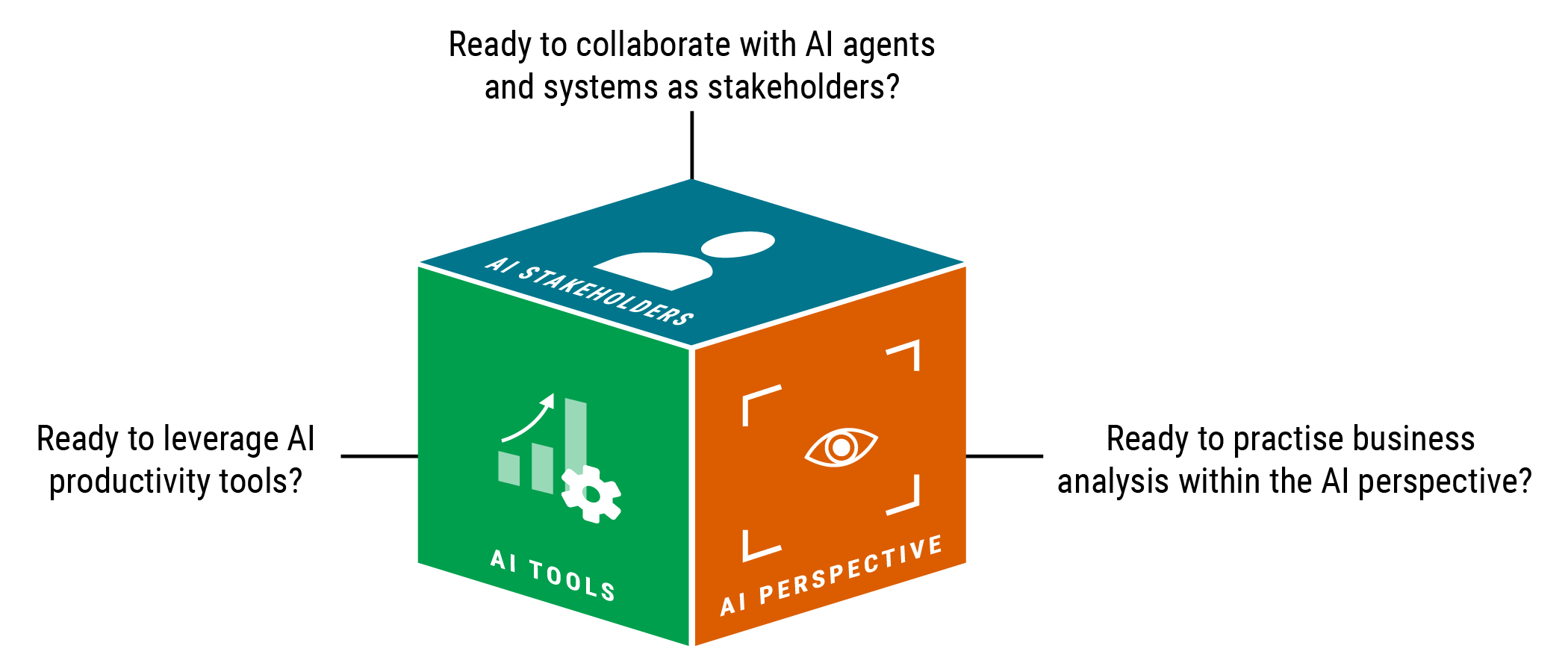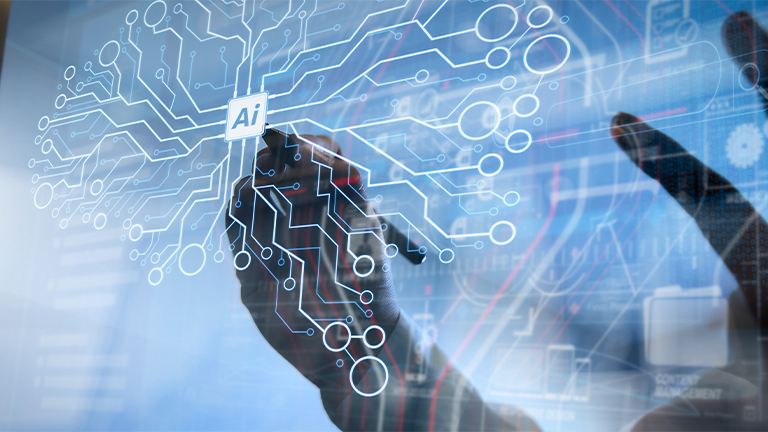Are You an AI-Ready Business Analyst?
Disclaimer: The views and opinions expressed in this article are those of the author and may not reflect the perspectives of IIBA.

Artificial intelligence (AI) is transforming the professional world at an unprecedented pace. From finance and healthcare to education and transportation, AI is permeating every sector.
According to a report by Microsoft and LinkedIn, 66% of leaders wouldn't hire someone without AI skills, and 75% of workers now use AI in their jobs. While AI has the potential to significantly enhance worker productivity, 45% of professionals worry that it might replace their jobs.
The rise of AI tools is leading to both opportunities and concerns. Are we moving toward a future where AI replaces workers or one in which, to use the words of Harvard Business School professor Karim Lakhani, "humans with AI are going to replace humans without AI"?
Regardless of one's perspective on this question, one thing is certain: AI is already redefining virtually all professions—including business analysis. But what does this transformation mean for business analysis professionals? What exactly is changing in this AI-driven world? Which competencies should practitioners develop to thrive in this new environment?
Building on my experience in professional development within the business analysis community, I developed the “AI-Ready BA Cube”—a model that visualizes how the business analysis profession is evolving due to the emergence of AI. It also helps identify the competencies needed to become AI-ready.
The AI-Ready BA Cube
The AI-Ready BA Cube identifies three key areas in which AI impacts business analysis.
Let's delve into each one.
AI as a Productivity Tool
According to A Guide to the Business Analysis Body of Knowledge (BABOK Guide), the ability to effectively use technological tools is a fundamental competency for any business analysis professional.1 A simple way to view business analysis is that practitioners, in collaboration with other stakeholders, apply business knowledge to analyze gathered information and produce various artifacts and deliverables.Traditional tools—such as office productivity, communication, and modelling tools—are primarily used for collaboration, artifact and deliverable production, and limited analysis. The emergence of AI, particularly generative AI with its unique reasoning and content generation capabilities, has significantly expanded the possibilities for business analysis professionals to leverage technology to enhance their productivity.
| Examples of New Technology Assistance Use Cases | |
| Collaboration | AI can take notes during meetings and generate a report with key follow-up items for participants |
| Business Knowledge | Business analysis professionals can leverage AI for general business knowledge, industry insights, or methodology guidance |
| Information Elicitation | AI can quickly analyze large documents and extract relevant data and information |
| Analysis of Information | AI can process the transcript of an elicitation meeting and translate it into a list of requirements |
| Production of Artifacts and Deliverables | AI can generate an initial version of a Business Requirements Document |
To thrive in an AI-powered world, business analysis professionals must learn to leverage AI tools and features to enhance their productivity. This includes developing a general awareness of AI technology and available AI tools, learning to select the right AI tool depending on the context and task, mastering prompt engineering to optimize AI outputs, and cultivating critical thinking to assess the accuracy of AI-generated results.
Above all, continuous learning is essential to staying current with evolving AI tools and technologies.
AI as a Stakeholder
Can your CEO be an AI-powered robot? Or could some of your colleagues be AI agents capable of collaborating and performing their jobs autonomously?In September 2022, Tang Yu, an AI-powered humanoid robot, was appointed CEO of the Chinese gaming company NetDragon Websoft. In early 2024, Devin, developed by Cognition AI, was hailed as the world's “first AI software engineer.” While these examples may seem far from the reality of most organizations around the world, we can anticipate a growing presence of AI agents and systems taking on fully autonomous roles in the coming years.
Although this emerging AI workforce doesn’t strictly fit the BABOK Guide definition of a stakeholder,2 since they aren’t persons per se, I strongly advocate that business analysts should consider them as stakeholders in business analysis initiatives.
How can a business analysis professional effectively engage with an AI who is the sponsor of an initiative? What is the best approach for communicating requirements to a virtual AI software engineer? They must learn to collaborate efficiently and responsibly with these virtual stakeholders. This requires not only applying traditional stakeholder engagement and management techniques with AI-specific considerations but also acquiring new competencies, such as specialized prompt engineering, to effectively engage with AI stakeholders.
AI as a New Perspective
AI represents a new perspective within the practice of business analysis, alongside more traditional perspectives such as agility, business intelligence, information technology, enterprise architecture, and process management. The role of the business analysis professional in AI-related initiatives involves unique considerations in performing certain tasks, employing distinct methods or approaches, or addressing unique concerns related to AI.According to a 2024 McKinsey survey, 72% of organizations have integrated AI into at least one of their business functions, a 30% increase from the previous year. As AI adoption continues to grow globally, business analysis professionals will increasingly play a role in AI-related initiatives.
In my view, there are three key areas where business analysts must adapt their practices to effectively contribute to AI-driven initiatives. First, they should learn how to drive the business case for AI adoption and assist in identifying relevant AI opportunities within their organization. Second, they need to understand the specificities of defining business requirements for AI-related initiatives. Finally, they must develop the expertise to manage trust, risk, and security concerns associated with AI.
Get AI-Ready
Being an AI-ready business analyst means being prepared across these three areas. So, I’ll ask you again: Are you an AI-ready business analyst? Maybe it's time to create a plan to improve your skills in all three areas!If you want to learn more about this fascinating topic, purchase Futureproof: Amplifying Agility with AI and Insightful Business Analysis by Angela Wick and Tim Coventry at the IIBA Bookstore.
References
- International Institute of Business Analysis. A Guide to the Business Analysis Body of Knowledge (BABOK Guide), Version 3.0. Toronto: International Institute of Business Analysis, 2015, 215.
- International Institute of Business Analysis. A Guide to the Business Analysis Body of Knowledge (BABOK Guide), Version 3.0. Toronto: International Institute of Business Analysis, 2015, 17.
About the Author

Paul Emmanuel NJIKI NJIKI is a Business Analysis Coach and Trainer at AIReadyBA.com, a bilingual platform developed by Alpha Oméga Numérique Inc., which he founded to help business professionals and organizations prepare for a digital and AI-driven world. An experienced business analysis practitioner, he also lectures on digital technology management at Université Laval, where he is particularly interested in the growing impact of AI on professionals, organizations, and society at large. Paul is an active leader in the business analysis community in Québec City, having served as VP of Professional Development for the local IIBA chapter from 2020 to 2024.


